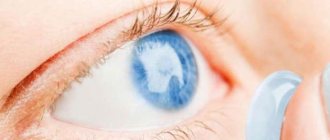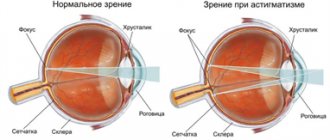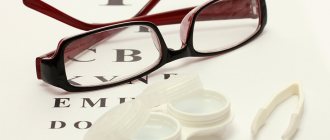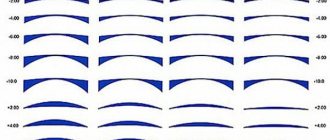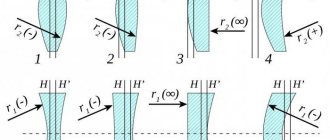Types of lenses for vision correction
Lenses are the basic element of corrective glasses. They provide high clarity of visual perception of objects. A prescription for lenses is written by an ophthalmologist depending on the vision pathology.
You can buy glasses with the following types of lenses:
1. Scattering. Designed to correct myopia. They have diopters with a “-” sign.
2. Collectors. Farsightedness is corrected. Optical power has a positive indicator, the “+” sign.
3. Aspherical. They are used to correct vision in case of astigmatism. The front side of the lens is spherical, the back is cylindrical.
Eyeglasses that correct these disorders are equipped with monofocal lenses. That is, they have one focus.
After 40 years, the elasticity of the lens decreases, causing vision deterioration.
. Age-related changes require wearing glasses with bifocal, progressive and office lenses. What is the difference:
1. Bifocal lenses have multi-directional diopters and help to simultaneously see objects at a great distance and distinguish those nearby. With lenses of this type, you do not have to purchase two pairs of glasses - for distance and reading. However, there is a sharp boundary between the far and near zones, which is why some patients experience significant discomfort.
2. Buying glasses with progressive lenses means getting the functionality of bifocal optics, but without clearly demarcated distance and near. These lenses provide a progression corridor, which allows you to see objects equally clearly over the entire available range of distances.
3. Office lenses are optical devices for near and medium distances. With their help, it is convenient to read, work at the computer, and look around the entire room. They are not intended for the street.
What to look for when purchasing
When going to purchase corrective glasses, you need to clarify in advance what they are. Since this type of product is classified as ophthalmological, the issue should be approached responsibly.
This type of product should be purchased only from specialized opticians who have been in the service market for several years and value their reputation. When purchasing, you should pay close attention to the main component of any glasses – the frame.
Manufacturers of ophthalmic products offer customers several types of frames:
- One-piece, able to frame the lenses completely.
- Half rim. This type of frames is easy to recognize by its appearance: the lenses in such glasses are fixed at the top, while the lower part remains free.
- Frame without rims. This type of frame is characterized by a direct connection between the temples and the glass. As a rule, corrective glasses are equipped with an additional fastening element between the lenses and the frame.
Metals and polymers are used to make these frames . Among the new products on the market of ophthalmic products are acetate frames. In order to purchase a truly high-quality product and not end up with a product from a company that has absolutely no idea about corrective glasses, it is necessary to find compliance with GOST in the characteristics.
Products made in accordance with the requirements of state standards comply with medical requirements for vision correction. You can purchase such a product without a shadow of a doubt.
Which lenses are suitable for corrective glasses?
In the production of successfully corrective glasses, mineral glass and organic materials are used to make lenses. Glass made from minerals has a transparent appearance. This type of lens is obtained by strongly cooling pre-molten components.
These lenses are distinguished by their heavy weight, but are resistant to mechanical stress . Lenses made from organic materials are a plastic product. These lenses are lightweight, but require additional surface treatment due to their inherent instability to mechanical stress.
Why is the opinion of a specialist important when choosing glasses?
Due to various diseases and deviations from the norm, only an experienced ophthalmologist will be able to select glasses. For this purpose, the client will be offered to undergo examination using special equipment. After a thorough examination, the patient will be offered options for frames and lenses for vision correction.
People diagnosed with ametropia are recommended to use telescopic glasses . These lenses perfectly magnify objects and contain one positive and one negative unit.
Patients suffering from pathology of the eye muscles should purchase prismatic glasses . Such products can provide effective assistance to bedridden patients. This is due to the possibility of refraction of rays at right angles, which is provided by prisms in the lenses. The patient can place a book on his chest and read it.
For patients with unilateral hemianopsia, ophthalmologists prescribe products with mirror lenses . Such lenses have reflective properties. These products can only be purchased with a doctor's prescription from a specialized optician. Usually the doctor indicates in the prescription a certain parameter characterizing the corrective direction of the glasses:
- distance between lenses;
- measurements for both eyes in diopters;
- indicator of optimal center displacement;
- characteristics according to the intended purpose of the optics.
To determine the optical power of the eyes, the doctor uses a special device - a dioptrimeter . Today it can be seen in all offices of ophthalmology clinics. To prevent the development of the disease, it is necessary to visit a doctor on time.
In addition to selection, an experienced doctor will be able to give recommendations or conduct a consultation for a person who is faced with such a purchase for the first time. Some types of corrective glasses are not intended to be worn constantly. They can be very effective when working with small objects, but are completely unnecessary when driving a vehicle.
Why is it important to consider your face type when choosing glasses?
When choosing glasses, it is important not only to choose the right lenses, but also to choose the frame to go with them. Experienced consultants in the optical salon will help the client make the right choice, taking into account his external data.
Glasses should emphasize the external attractiveness of their owner, and not repel others from him. For this purpose, several basic rules should be taken into account:
- Frames without a rim or with a half-rim are not suitable for those with a long face. The ideal option for them would be medium-sized glasses.
- Those with a wide forehead are better off opting for high-waisted products.
- Those with large noses should choose low-rise glasses. A frame with a double bridge would also be an excellent option.
- If there are clear proportions in the face, you can choose products with any frame.
In addition to choosing a shape, you can also choose the color of the frame , in accordance with the color of your hair. Black frames are suitable for brunettes. For people with red hair, we can recommend frames with a bronze tint. Brown-haired women should prefer frames in red, brown or gold. And blondes should choose frames of a golden or silver shade.
Glasses for vision: how to select lenses
Selection of corrective optics
occurs in several stages:
● an ophthalmologist-optician collects anamnesis;
● measures the distance between the pupils;
● determines the dominant eye;
● reveals visual acuity at far and near distances;
● determines refraction;
● finds out whether the image quality is the same for the right and left eyes in selected trial lenses;
● tests the tolerability of the correction (for this, the patient needs to walk or read for some time using a trial version);
● using a diopter meter, the doctor determines the indicators of the previous pair of glasses, if the patient has already used them;
● based on the results of the examination, writes a prescription for lenses.
Sometimes patients have non-standard pupil alignment or other atypical eye features, which makes it impossible to buy glasses from a warehouse. In this case, individual manufacturing of optics is necessary. The price of custom-made glasses is usually higher than ready-made glasses.
Integrated Lens Technology (ILT)
The product range of this Singapore-based company, whose products have recently appeared on the Russian market, includes many interesting solutions for the manufacture of prescription sunglasses. The 2009/10 ILT lens catalog includes more than 50 types of prescription and commercially available lenses with various functions to protect against excess luminous flux. In particular, the company offers single vision polymer lenses made from materials with a refractive index from 1.50 to 1.67 and polycarbonate; bifocal, progressive and custom progressive lenses made using Free Form technology with coloring in grey, brown and grey-green, with light absorption of 65 or 80% and with two options of anti-reflective coatings on the back surface of the lens - standard and superhydrophobic STEEL. All lenses provide UV protection up to 400 nm. Most of these lenses can be produced in a photochromic version using Transitions VI technology or SunActives' proprietary technology.
The next group of lenses that deserves attention are single-vision polarized lenses of the X-treme series in gray and brown colors: X-treme 1.5 Polarview, X-treme 1.6 Polarview, X-treme Polycarbonate Polarview, X-treme 1.67 Polarview, as well as progressive polarized lenses Calligraphy 1.5 Polarview, Calligraphy Polycarbonate Polarview, Calligraphy 1.67 Polarview; They all combine the benefits of a unique design with effective protection against glare and glare. X-treme aspherical and atoric lenses utilize the latest technology in single vision lens design to provide high clarity of vision when looking in any direction.
In addition, the product range includes Future-X G2 Tint single vision lenses with light absorption up to 80%, as well as Future-X ASP Mirror lenses with a mirror coating on the front surface of the lens and an anti-reflective coating on the back. For their manufacture, an innovative material was used with a refractive index of 1.557, an Abbe number of 43 and a specific gravity of 1.16 g/cm3 with high strength characteristics. The unique properties of the material make it possible to combine lightness, thinness and high transparency with exceptional impact resistance in Future-X lenses. Thanks to ILT’s collaboration with Younger Optics, Drivewear lenses, which are rapidly gaining popularity, have become available for order.
The Explorer lens production technology is based on the same principles - a combination of photochromic and polarization properties. These spherical design lenses with a refractive index of 1.50 and STEEL superhydrophobic coating are available in brown and grey. Originally designed for golfers who are known to spend hours outdoors, Explorer lenses are ideal for all types of active activities in varying light conditions. And to ensure the installation of lenses in sportswear frames, ILT offers Explorer lenses with a base curvature of 6.00 or 8.00 diopters and a diameter of up to 75 mm.
Types of spectacle frames
This element is designed to fix the lens
. The correct position of the optics relative to the eyes depends on how accurately the frame is selected. Vision glasses have a frame consisting of the following elements:
● rims holding the lens;
● temples that provide fixation on the face;
● a bridge connecting the rims.
Sometimes the tightness of the glasses' fit to the bridge of the nose can be adjusted using movable nose pads made of rubber or silicone.
Modern frames vary in:
1. Shape: square, round, oval. Nowadays, women's glasses for myopia or farsightedness, similar to a cat's eye, are relevant.
2. Material of manufacture: acetate, plastic, metal, their combination.
3. Designs: rimmed, semi-rimmed and rimless.
4. Design: you can buy glasses with frames decorated with rhinestones, precious stones and other decorative elements.
How to choose quality corrective glasses
Vision correction products are ubiquitous today. Such products can be purchased even in markets, but how high quality will such an acquisition be?
Many people with vision problems have no idea about corrective glasses. Therefore, if the need arises to purchase such a product, people often act rashly and purchase low-quality goods .
Subsequently, a person may experience a number of negative consequences from such an acquisition:
- Pain and pain in the eyes.
- Continued decrease in vision.
- Skin irritation leading to an allergic reaction caused by poor-quality materials in the manufacture of frames.
- The inharmonious appearance of glasses on the face of its owner. In very rare cases, street vendors can choose the right frame for a client.
Frame selection
The frame for your vision glasses should be selected not only taking into account personal preferences. also important to pay attention to the features of the lenses
.
So, with myopia
of -4, the lens will be thin in the center and thicker at the edges.
A plastic frame with a wide temple will help disguise the edges. If there is a significant plus or minus,
opticians do not recommend “invisible” frames with lens fastening with screws.
With farsightedness,
there is a risk of distortion due to the thinness of the lens at the edges.
And for thick edges
of negative optics, the length of the fastener may not be enough.
Where to buy corrective glasses?
You can buy glasses for vision correction in different places. Someone buys them in passages, in stalls, on trains. The quality of such a product will be questionable, because it is impossible to check where the product was produced and what materials were used for it. Any ophthalmologist in Samara or any other city will advise you to avoid these products, since they can cause irreparable harm to health. Their vision can only deteriorate further, resulting in the need for expensive surgery.
Corrective glasses purchased in unknown places may have low-quality frames that will put pressure on the temples or, on the contrary, fall off the face. If the materials are cheap, they can easily cause allergies or skin diseases. There is a risk of headaches from the frames. If cheap lenses are used in glasses, then they can lead to eye strain.
You can keep silent about the design of cheap glasses - peeling paint, old-fashioned style, terrible fittings. Such glasses are unlikely to suit a person who follows fashion at least a little.
